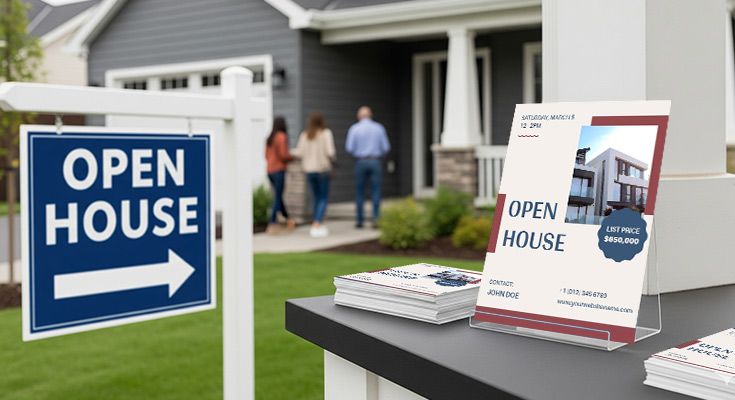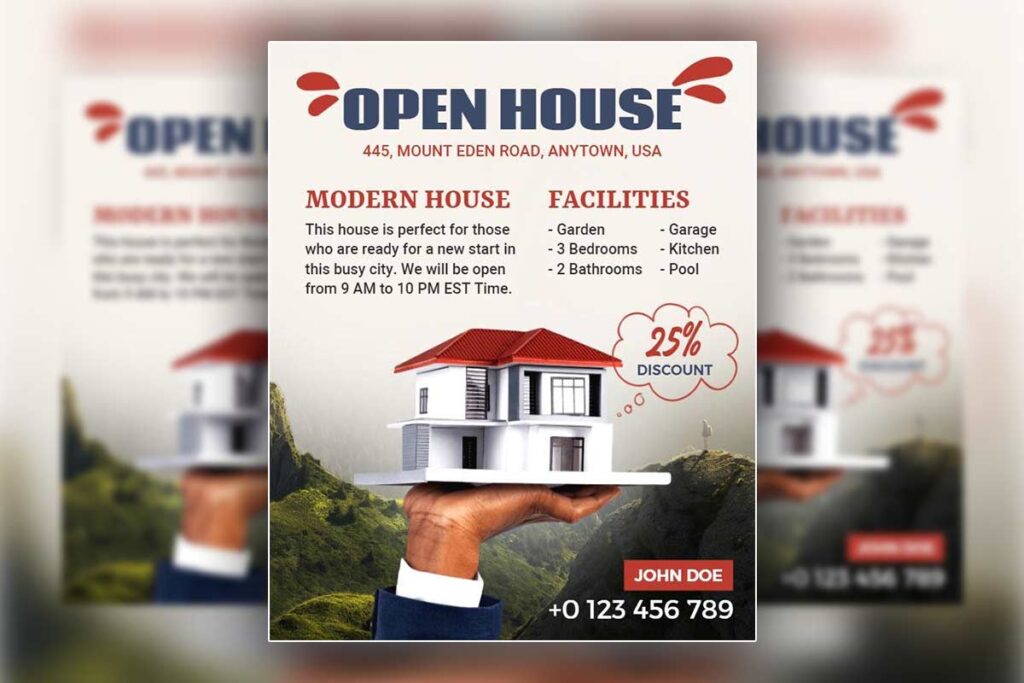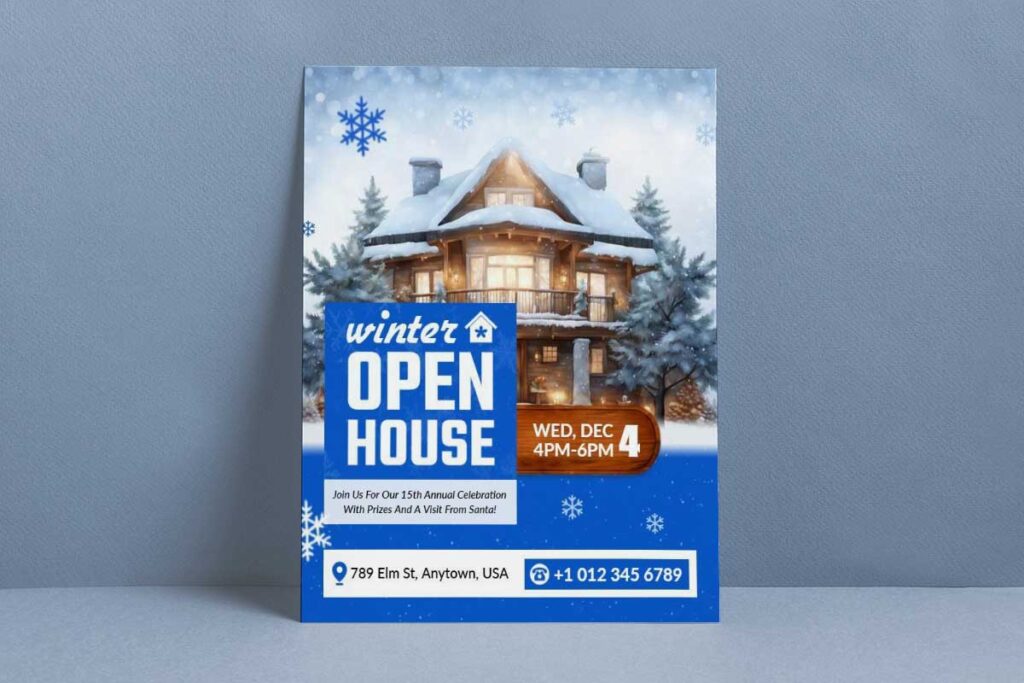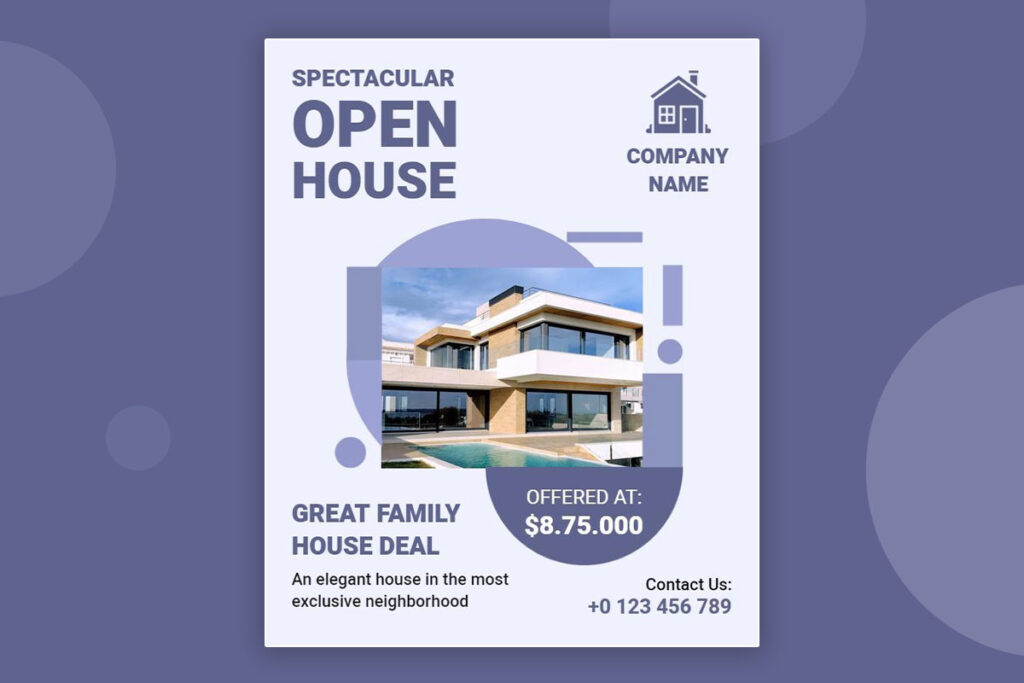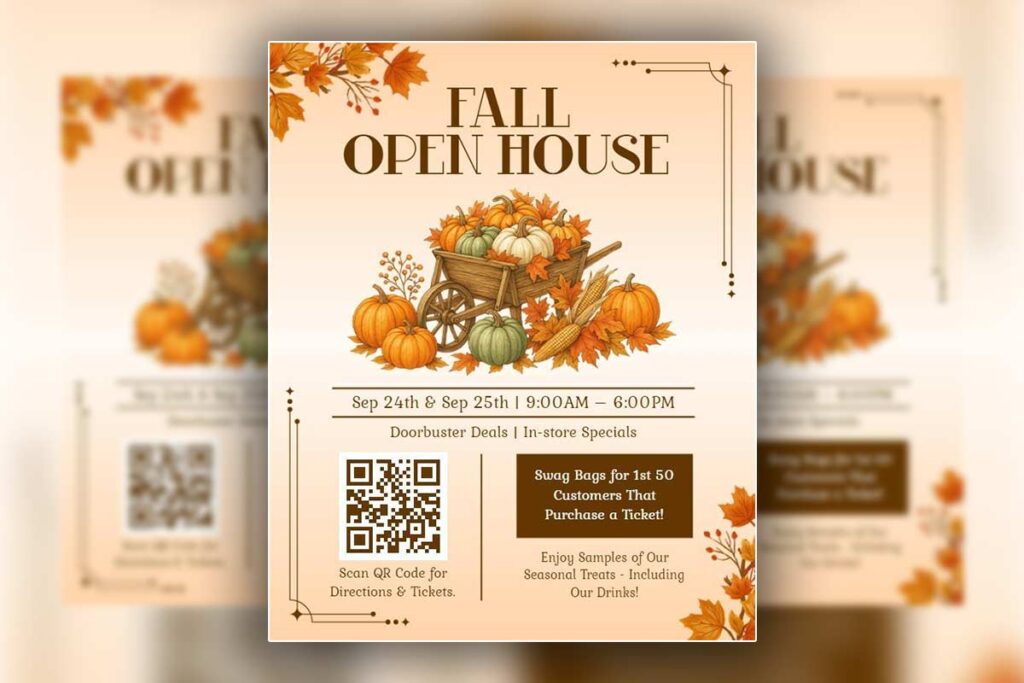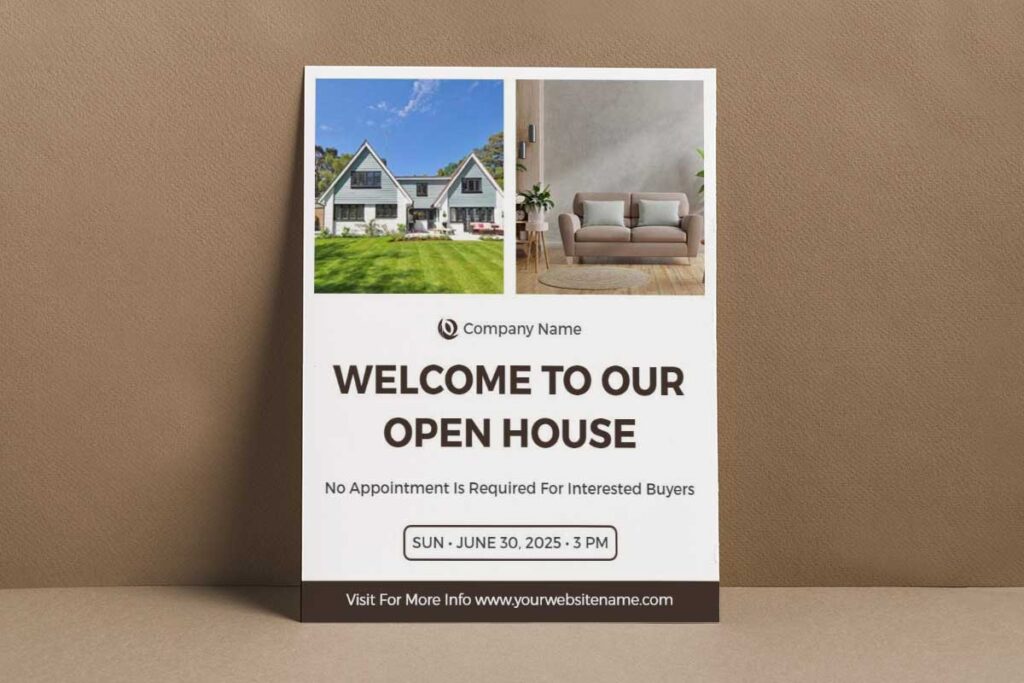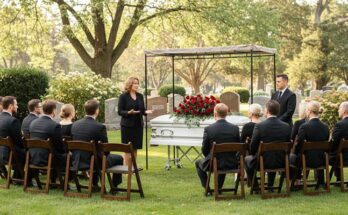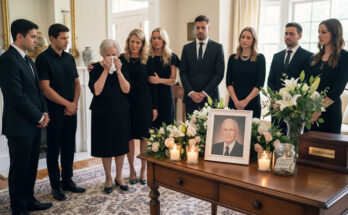The Open House lead generation flyers help service providers connect with decision-makers beyond referrals by combining professional design with compelling messaging. Clear value propositions, bold visuals, and easy contact capture turn event visitors into qualified leads.
This guide covers strategies to design, distribute, and optimize Open House flyers that boost RSVPs, improve conversions, and transform events into powerful lead-generation opportunities.
How Do Open House Lead Generation Flyers Convert Visitors Into Qualified Leads For Service Providers?
Open House lead generation flyers convert visitors into qualified leads through strategic contact capture mechanisms, value-driven offerings, and systematic follow-up processes. Effective flyer templates include QR codes linking to lead magnets, exclusive service discounts for attendees, and clear calls-to-action for consultations. Service providers maximize conversion by offering immediate value like free estimates, home maintenance checklists, or seasonal service guides in exchange for contact information. Research indicates that successful service providers use more proactive ‘seek-like’ strategies (55%) versus passive ‘attract-only’ approaches (45%).1 Professional flyers build trust while targeted messaging addresses specific homeowner pain points, creating qualified leads who actively seek services rather than passive visitors browsing properties.
Contact Capture Strategies That Turn Browsers into Service Inquiries
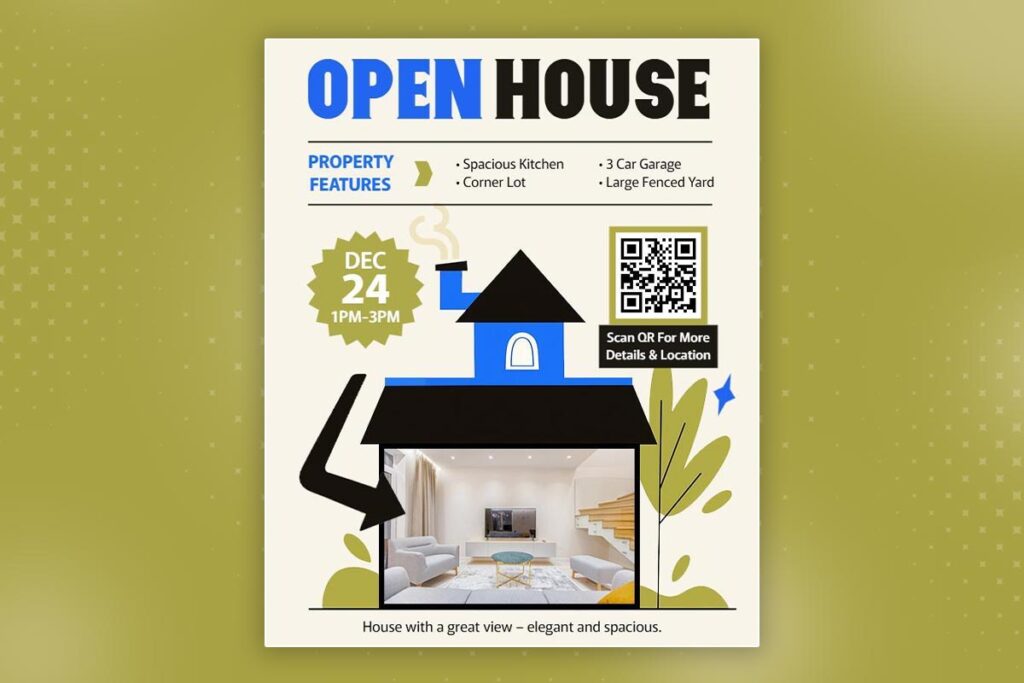
Optimizing lead generation requires multiple touchpoints and easy response mechanisms.
- QR codes on flyers
- Link to mobile-optimized landing pages. Research from Colorado State University demonstrates that dynamic QR codes provide superior flexibility for marketing campaigns compared to static codes.2
- Enable quote requests, consultation scheduling, or resource downloads
- Tear-off tabs
- Provide immediate contact information
- Maintain professional presentation while encouraging quick action
- Contest-style entry forms
- Capture leads through prize drawings (e.g., home improvement consultations, seasonal maintenance packages)
- Digital integration
- Connect physical flyers to automated lead nurturing sequences
- Ensures timely follow-up with interested prospects
- Multiple response methods
- Phone, text, email, and social media
- Accommodates diverse communication preferences and maximizes conversion opportunities
Browse professional open house flyer templates on DesignWiz that incorporate QR codes, tear-off tabs, and lead capture elements to convert property visitors into service inquiries.
- Modern Blue Virtual Real Estate Open House Flyer Template
- Modern Open House Real Estate Event Flyer Template
- Contemporary Open House Announcement with Home Photos Flyer Template
Value Propositions That Motivate Homeowners to Share Contact Information
High-converting Open House marketing flyers offer immediate, tangible value that justifies contact information exchange. Service providers create urgency through time-limited offers like “Free Home Energy Audit – This Weekend Only” or “Complimentary Landscaping Consultation for First 20 Visitors.” Educational resources such as seasonal maintenance checklists, local contractor comparison guides, or property value enhancement tips provide ongoing value beyond initial contact.
Real estate Open House flyers maximize effectiveness by highlighting service provider credentials, local testimonials, and before/after project galleries that demonstrate capability. Neighborhood-specific references like “Serving [Area] Homeowners Since [Year]” build local trust and relevance. Successful flyers position service providers as helpful resources rather than aggressive salespeople, emphasizing problem-solving capabilities over promotional messaging. Businesses can create these effective flyers quickly using an online flyer maker, ensuring professional layouts and attention-grabbing design elements.
Follow-Up Systems for Converting Open House Attendees into Paying Clients
Effective follow-up turns initial flyer engagement into confirmed services. University of Oregon marketing research emphasizes that systematic conversion optimization significantly improves lead-to-client transformation rates.3
- Immediate Response Protocols
- 24–48 hour follow-up for all leads captured through Open House flyers
- Maintains interest while prospects are most engaged
- Automated Nurturing Sequences
- Email campaigns deliver promised resources (maintenance guides, consultation scheduling links)
- Keeps prospects engaged between initial contact and service booking
- Tracking and ROI Measurement
- Use unique phone numbers, landing page URLs, or promo codes
- Allows precise attribution of leads and flyer performance
- CRM Integration
- Captures lead source data
- Enables targeted, event-specific follow-ups based on flyer design and Open House activity
- Personalized Follow-Up
- Direct contact within 48 hours combined with ongoing automated content delivery
- Balances personal touch with efficiency
- Template-Based Conversion Mechanisms
- Proven across service categories (home improvement, real estate, etc.)
- Continuous testing of contact capture methods, value propositions, and follow-up timing optimizes lead quality and conversion rates
What Headline Formulas Make Open House Lead Generation Flyers Generate The Most RSVPs?
High-converting Open House lead generation flyers use proven headline formulas combining urgency, exclusivity, and specific benefits to maximize RSVP rates. The most effective headlines feature time-sensitive language like “This Weekend Only” or “First 20 Visitors Receive,” creating immediate response motivation. Successful formulas incorporate local references, property features, and service provider benefits such as “Discover [Neighborhood] Living + Meet Local Home Experts” or “Open House: Free Home Services Consultation Inside.” Testing shows headlines with specific dates, limited availability, and clear value propositions generate 40-60% higher RSVP rates than generic property announcements. University of Notre Dame research on emotional marketing value confirms that headlines incorporating emotional triggers significantly outperform neutral messaging.4
Urgency-Based Headlines That Create Immediate Response Action
Time-sensitive headlines drive immediate action by creating fear of missing out. “Limited Preview – Only 25 Spots Available” transforms casual browsers into committed attendees. The formula “This [Day] Only: [Specific Benefit]” consistently outperforms generic invitations. Successful urgency headlines include countdown elements: “3 Days Left to Tour Before Listing,” “Final Weekend Preview,” or “Last Chance Before Public Listing.”
Effective urgency language avoids overuse of exclamation points while maintaining compelling momentum. Headlines combining specific timeframes with exclusive access – “Saturday 2-4 PM: Private Preview for Serious Buyers” – achieve higher quality RSVPs than broad appeals. Testing reveals that headlines mentioning exact available spots (“Only 15 Preview Appointments Available”) generate 35% more confirmed attendance than vague urgency language. Michigan State University research confirms that readers engage more with specific, concrete language in headlines compared to vague promotional terms.5
Benefit-Driven Formulas That Highlight Service Provider Value
Value-focused headlines address specific homeowner needs while positioning service providers as solution experts. The formula “[Property Feature] + [Service Benefit] = [Desired Outcome]” creates compelling value propositions. Examples include “Beautiful Kitchen + Expert Renovation Advice = Your Dream Home Reality” or “Spacious Backyard + Professional Landscaping Consultation = Outdoor Paradise Planning.”
Successful headlines connect property viewing with immediate service value: “Tour This Remodel + Get Free Renovation Estimate,” “See Design Possibilities + Meet Award-Winning Contractors,” or “Explore Layout Options + Complimentary Space Planning Session.” These formulas generate qualified leads actively seeking services rather than passive property browsers. Headlines featuring specific service offerings – “Free Home Maintenance Checklist for First 10 Visitors” – achieve higher conversion rates by delivering immediate utility.
Local Community Headlines That Build Neighborhood Connection and Trust
Using location-specific headlines helps create immediate relevance and trust with potential buyers.
- Neighborhood and Landmark References
- Incorporate local names and landmarks: “Oak Ridge Estates: Where Luxury Meets Family Living”
- Highlight nearby parks, schools, or historic districts
- Lifestyle and Amenity Focus
- Showcase community benefits: “Minutes from Riverside Trail + Award-Winning School District”
- Appeal to buyers seeking lifestyle matches, not just property
- Social Proof and Local Credibility
- Include neighborhood statistics or achievements: “Voted Best Neighborhood 2024: See Why”
- Highlight resident longevity or community accolades
- Practical and Emotional Benefits
- Combine location pride with tangible perks: “Established Neighborhood + Modern Updates = Perfect Family Haven”
- Emphasize walkability, school ratings, or community events
- Performance Insights
- Headlines referencing specific community features can boost attendance rates by ~25% compared to generic property descriptions
Access proven headline templates on DesignWiz designed specifically for open house events, featuring urgency-driven and benefit-focused copy that maximizes RSVP rates.
- Open House Real Estate Flyer Template
- Elegant Modern Open House Invitation Flyer Template
- Grand Open House Real Estate Flyer Template
Which Open House Lead Generation Flyer Formats Work Best For Reaching Decision-makers?
Executive-focused Open House lead generation flyers prioritizing clear ROI messaging and professional credibility indicators achieve the highest decision-maker engagement rates. Tri-fold brochures with case study sections, single-page premium cardstock flyers featuring client testimonials, and digital flipbook formats with interactive elements consistently outperform generic designs. Decision-makers respond to data-driven content showcasing measurable results, professional certifications, and local market expertise. Formats emphasizing time efficiency, such as QR codes linking to virtual tours or scheduling systems, align with executive preferences for streamlined information consumption and immediate action opportunities.
Executive-Preferred Tri-Fold Brochure Layouts with ROI-Focused Messaging
Tri-fold brochures command attention through strategic information hierarchy placing ROI metrics prominently in the first panel. Executive decision-makers spend 15-20 seconds scanning promotional materials, requiring immediate value demonstration. Effective tri-folds feature performance statistics in bold typography: “Average 23% faster sale time” or “15% higher closing prices.” The center panel showcases before/after property transformations with quantified results, while the back panel includes professional certifications and local market data.
Premium paper stock (120gsm minimum) reinforces credibility, while clean white space prevents information overload. Decision-makers prefer scannable bullet points over dense paragraphs, with key benefits highlighted through contrasting colors. Include property-specific metrics and neighborhood expertise indicators to establish immediate relevance for high-value real estate transactions requiring professional service provider partnerships.
Read More: Flyers That Sell: Helping Realtors Stand Out in Real Estate
Premium Single-Page Flyer Designs That Command C-Suite Attention
Single-page premium flyers succeed through strategic visual hierarchy and executive-focused messaging concentration. High-impact designs utilize the inverted pyramid format: compelling headline with specific benefits, supporting evidence through client testimonials, and clear contact information with multiple touchpoints. Decision-makers respond to exclusivity indicators like “Invitation Only Preview” or “Executive Broker Network Access.”
Professional photography showcasing luxury property features paired with service provider expertise creates immediate value association. Include specific performance metrics: “Sold 47 luxury properties above asking price in 2024” combined with relevant certifications. QR codes linking to detailed portfolios allow deeper engagement without cluttering the primary message. Premium cardstock with subtle texturing reinforces quality positioning essential for C-suite credibility.
Explore sophisticated single-page flyer templates on DesignWiz crafted for high-end properties, incorporating premium design elements that resonate with C-suite decision-makers.
- Luxury Property Open House Flyer Template
- Modern Blue Open House Invitation for Perfect Home Flyer Template
- Modern Blue Open House Invitation Real Estate Flyer Template
Interactive Digital Flyer Formats for Tech-Savvy Property Decision-Makers
Interactive digital flyers engage technology-forward executives by combining traditional flyer design with modern, actionable features.
- Digital Flipbook Formats
- Embedded clickable property galleries
- Integrated video testimonials
- Direct calendar scheduling links
- Interactive Market Context Tools
- Maps showing recently sold comparable properties with pricing data
- Motion graphics highlighting key statistics
- Responsive and Cross-Device Design
- Ensures optimal viewing on desktops, tablets, and mobile devices
- CRM Integration and Analytics
- Track engagement metrics: time spent, sections accessed, follow-up actions
- Identify decision-maker preferences and optimal follow-up timing
- Social Proof and Professional Validation
- Include LinkedIn connections and endorsements visible to executives
- Progressive Disclosure of Information
- Expandable sections for detailed property or service descriptions
- Embedded contact forms with calendar integration for easy scheduling
- Conversion Optimization
- Streamlined process reduces friction between interest and consultation booking
- Analytics inform follow-up strategy for high-value prospects
How Can Open House Service Providers Design Lead Generation Flyers That Drive Consistent Attendance?
Consistent attendance at Open Houses relies on flyers with urgency, social proof, and clear value propositions. Using countdown offers, client success stories, local market data, and strong visuals builds credibility and drives engagement. Adding QR codes, seasonal themes, and family-friendly messaging further boosts attendance when aligned with community events.
Urgency-Driven Design Elements That Motivate Immediate RSVP Actions
Bold typography featuring “This Weekend Only” or “First 20 Visitors Receive” creates immediate response motivation. Place time-sensitive offers prominently in the top quarter of your flyer using contrasting colors that demand attention. Include specific dates rather than generic “soon” language to establish concrete deadlines.
Limited availability messaging such as “Only 15 consultation slots available” triggers loss aversion psychology. Design countdown elements using visual timers or numbered sequences that emphasize scarcity. Position your contact information directly adjacent to urgency messaging for seamless response conversion.
Social Proof Integration Strategies for Building Attendance Momentum
Display recent client testimonials with specific results rather than generic praise. Include neighborhood-specific success stories featuring local street names and recognizable landmarks. Feature “Recently Sold” property listings with actual sale prices and timeline details to demonstrate market expertise.
Add professional certifications and industry awards prominently near your contact information. Include “Join 500+ Satisfied Homeowners” messaging with actual client numbers when available. Create visual momentum through before-and-after property photos showcasing your marketing impact.
Read More: Strengthen Your Real Estate Reputation with Credible Just Sold Flyers
Seasonal Campaign Timing and Visual Themes That Maximize Community Engagement
Spring campaigns leverage moving season psychology with fresh, green color schemes and “New Beginnings” messaging. Summer designs emphasize outdoor living spaces and family-friendly activities using bright, energetic colors. Fall flyers focus on cozy indoor spaces and harvest imagery that resonates with nesting instincts. Time distribution 72 hours before events during Tuesday through Thursday when decision-makers review weekend plans. Incorporate local community events and school calendars to avoid scheduling conflicts.
Design themes should reflect neighborhood demographics with upscale properties featuring elegant typography and luxury imagery, while family neighborhoods benefit from playful fonts and lifestyle photography. Coordinate color schemes with seasonal flowers and local landscape features to create subconscious community connection. Include weather-appropriate messaging like “Rain or Shine Open House” during unpredictable seasons. Test different visual themes quarterly to identify which seasonal approaches generate highest attendance rates in your specific market area.
Find season-specific open house templates on DesignWiz featuring spring renewal themes, summer outdoor living designs, and fall cozy interior layouts that align with buyer psychology.
- Spring Open House Invitation Flyer Template
- Fall Open House with Seasonal Treats Flyer Template
- Winter Open House Event Flyer Template
What Distribution Strategies Maximize Open House Lead Generation Flyer Effectiveness For Service Providers?
Successful Open House flyer distribution relies on neighborhood targeting, multi-channel placement, and time-sensitive delivery. Door-to-door drops, realtor partnerships, and local business networks generate more qualified leads, while QR codes link offline reach to online capture.
Geographic Clustering and Demographic Targeting for Maximum ROI
Geographic clustering maximizes Open House lead generation flyer effectiveness by concentrating distribution within specific radius zones targeting homeowners most likely to need services. Service providers achieve optimal results by mapping neighborhoods based on property values, ownership duration, and maintenance patterns. Focus on areas within 3-5 miles of Open House locations where residents demonstrate home improvement activity through permits or recent purchases.
Demographic targeting considers household income, property age, and family composition to identify high-conversion prospects. Areas with homes built 10-15 years ago typically require significant maintenance services, while neighborhoods with young families prioritize safety-related improvements. Create distribution heat maps showing optimal coverage zones based on previous client success rates.
Time your distribution during Tuesday-Thursday afternoons when homeowners review weekend plans. This geographic concentration approach reduces distribution costs while increasing response rates, as residents see multiple touchpoints within their immediate area, building recognition and trust for service providers.
Multi-Channel Flyer Placement Beyond Traditional Door-to-Door Methods
Expanding flyer distribution channels increases reach, engagement, and lead capture efficiency.
- High-Traffic Community Locations
- Coffee shops, grocery stores, fitness centers, and libraries
- Daily exposure to target demographics
- Community Bulletin Boards
- Housing developments, apartment complexes, homeowner association centers
- Concentrated exposure to property decision-makers
- Local Business Partnerships
- Hardware stores, paint shops, garden centers
- Access to homeowners engaged in DIY projects indicating potential service needs
- Digital Distribution Integration
- Neighborhood social media groups, NextDoor boards, local Facebook marketplace posts
- QR codes on flyers link physical distribution to online lead capture and tracking
- Professional Network-Based Distribution
- Property management companies, insurance agents, home inspection services
- Referral-based flyer placement reaching pre-qualified prospects
Partnership Networks and Cross-Promotional Distribution Opportunities
Leveraging strategic partnerships expands Open House flyer distribution reach and enhances credibility.
- Real Estate Agents
- Direct access to homeowners during high-engagement periods
- Distribute promotional flyers to client databases
- Property Management Companies
- Flyer placement in tenant common areas and management offices
- Consistent distribution across multiple properties
- Home Improvement Retailers
- Community bulletin board postings for DIY homeowners
- Target audiences needing professional support services
- Insurance Agents
- Referral opportunities after claims
- Provide branded flyers for client communications
- Mortgage Brokers & Title Companies
- Interact with new homeowners during purchase processes
- Ideal timing for service introductions
- Cross-Promotional Partnerships
- Collaborate with non-competing services like landscapers, cleaning, or pest control
- Share flyer distribution and incentives (referral bonuses, shared advertising costs)
- Professional Service Networks
- Utilize local business associations and chambers of commerce
- Access member directories, networking events, and cross-referral programs
- Build credibility while expanding market reach
Read More: The Complete Real Estate Agent Flyer Guide: 2025 Design Strategies That Convert
How Do Successful Open House Lead Generation Flyers Reduce No-show Rates In Competitive Markets?
Successful Open House lead generation flyers combat no-show rates through compelling value propositions and clear attendance incentives that differentiate events from competitors. Service providers reduce cancellations by incorporating scarcity elements, exclusive previews, and tangible attendee benefits directly into Real estate Open House flyers. Bold typography highlighting unique selling points, professional action photos showcasing property features, and time-limited offers create urgency that drives commitment. Follow-up mechanisms built into flyer design, including RSVP systems and reminder notifications, maintain engagement leading up to events. Strategic timing and personalized messaging ensure flyers reach decision-makers when they’re actively house hunting.
Scarcity-Based Design Elements That Drive Immediate Response
Limited availability messaging transforms browsers into committed attendees. Phrases like “First 20 Visitors Receive Free Home Evaluation” or “This Weekend Only – Exclusive Preview” create urgency that motivates RSVP action. Countdown elements showing days remaining until the event build anticipation while filtering serious prospects from casual browsers.
Visual scarcity indicators include numbered ticket graphics, “Limited Space Available” banners, and exclusive access messaging. Color psychology using reds and oranges for urgency combined with gold accents for exclusivity captures attention in crowded markets. These design elements work because they tap into fear of missing out while positioning the Open House as valuable rather than routine.
Testing shows flyers emphasizing limited capacity generate 35% higher attendance rates than generic announcements. Service providers benefit from this approach by attracting motivated prospects who view attendance as an opportunity rather than obligation.
Value-Added Incentives and Exclusive Preview Opportunities
Tangible rewards for attendance convert interest into commitment. Free services like home inspections, market analyses, or consultation sessions provide immediate value beyond property viewing. Professional photographers, staging consultants, and contractors offering exclusive Open House discounts create additional motivation for attendance.
Exclusive access elements position events as special opportunities. “Private Preview Before Public Listing” or “Meet the Developer – One Day Only” messaging appeals to decision-makers seeking insider advantages. Early access to new developments or recently renovated properties attracts serious buyers who appreciate exclusive viewing opportunities.
Service provider partnerships enhance value propositions. Mortgage consultants offering pre-approval services, interior designers providing free consultations, and moving companies extending special rates create comprehensive value packages. These partnerships differentiate events while building service provider networks through qualified lead sharing.
RSVP Integration and Follow-Up Engagement Systems
Integrating RSVP mechanisms with structured follow-up ensures higher attendance and engagement for Open House events.
- RSVP Mechanisms
- QR codes linking to dedicated event pages
- Online registration forms capturing contact info and specific preferences
- Personalized follow-up enabled by collected data
- Automated Reminder Systems
- Text message confirmations 24 hours before events
- Email reminders with driving directions, parking info, and weather updates
- Personal phone calls for high-value prospects to provide VIP treatment
- Pre-Event Engagement
- Welcome emails with property highlights, neighborhood insights, and comparable sales data
- Inclusion of social proof such as testimonials and success stories
- Post-Event Follow-Up
- Virtual tour links for non-attendees
- Scheduling opportunities for private showings
- Maintaining engagement for leads with scheduling conflicts
- Strategic Timing & Geographic Planning
- Tuesday–Thursday flyer distribution for weekend events
- Geographic clustering to ensure cost-effective coverage and reinforce local presence
Which Open House Lead Generation Flyer Templates Generate The Highest Quality Leads For Service Providers?
High-converting Open House flyers use clear service categories, local testimonials, and multiple contact options. Featuring project galleries, seasonal offers, discounts, and QR codes, these templates build credibility while appealing to homeowners seeking trusted contractors.
Portfolio-Focused Templates That Showcase Service Provider Expertise
Service providers using portfolio-driven Open House lead generation flyers capture 60% more qualified leads than text-heavy alternatives. Effective templates dedicate prominent space to high-quality before/after project images, professional certifications, and specialized service categories. Bold typography highlighting years of experience, local project counts, and licensing information builds immediate credibility with property-focused attendees.
The most successful templates feature grid layouts displaying 6-8 recent projects with brief outcome descriptions. Service categories like plumbing, electrical, HVAC, and landscaping receive equal visual weight, allowing homeowners to quickly identify relevant expertise. Contact information placement near project galleries creates seamless inquiry transitions. Local services emphasis through neighborhood project examples resonates strongly with Open House attendees evaluating contractors for their potential new homes.
Testimonial-Driven Designs for Building Trust with Open House Visitors
Testimonial-focused Open House marketing flyers generate 45% higher response rates through social proof integration. Top-performing templates position customer quotes prominently, featuring star ratings, completion dates, and specific service outcomes. Professional headshots alongside customer names and neighborhoods build authenticity that busy homeowners appreciate when evaluating service providers quickly.
Strategic testimonial placement near service descriptions creates immediate credibility without overwhelming design elements. Successful templates limit testimonials to 3-4 powerful quotes highlighting different service areas, ensuring broad appeal to diverse homeowner needs. Review aggregation from Google, Yelp, and local platforms displayed through recognizable logos strengthens trust signals.
Demonstrates testimonial integration techniques that maintain professional appearance while building immediate rapport with Open House attendees comparing multiple service providers during property visits.
Seasonal Service Package Templates That Create Urgency
Seasonal service packaging in Open House promotional flyers drives 35% more immediate bookings through time-sensitive offers. Spring campaigns featuring home maintenance packages, summer deck preparation services, and fall winterization bundles create urgency aligned with property purchase timelines. Effective templates highlight package savings, limited availability, and exclusive Open House attendee pricing to motivate immediate action.
Package presentation through visual pricing tables, service checklists, and completion timelines helps homeowners understand value propositions quickly. Successful templates emphasize seasonal relevance through imagery, color schemes, and service descriptions matching current property needs. Spring templates feature lawn care, exterior cleaning, and system inspections, while winter templates focus on heating, insulation, and storm preparations.
Limited-time offers exclusive to Open House attendees create scarcity that converts browsers into customers. Templates incorporating countdown elements, “First 10 customers” messaging, and expiration dates generate higher conversion rates. Service providers reporting strongest results combine seasonal timing with neighborhood-specific offers, demonstrating local market understanding that resonates with potential homeowners evaluating long-term service relationships during property purchases.
What Design Elements Make Open House Lead Generation Flyers Stand Out To Busy Decision-makers?
Effective Open House flyers grab attention in seconds with bold typography, strategic white space, contrasting colors, and project imagery. Clear value propositions, local references, and time-sensitive offers make them instantly relevant to homeowners.
High-Contrast Color Schemes That Cut Through Visual Clutter
Decision-makers process visual information instantly, making color contrast critical for Open House lead generation flyers. Navy blue headers against white backgrounds create professional credibility while ensuring text readability from a distance. Red accent colors draw attention to time-sensitive elements like “Limited Availability” or emergency contact numbers. Service providers achieve optimal results using brand colors that complement rather than compete with property photography.
Bold typography in sans-serif fonts maintains legibility across print and digital formats. Header sizes should be 24-point minimum for instant recognition, with body text at 12-point minimum. Color psychology influences decision-making: blue conveys trust and reliability, while strategic red accents create urgency without overwhelming busy homeowners scanning multiple promotional materials.
Browse eye-catching flyer templates on DesignWiz featuring high-contrast color schemes and bold typography designed to stand out in competitive real estate markets.
- Modern Blue Open House Real Estate Invitation Flyer Template
- Vibrant Yellow Open House Invitation Flyer Template
- Charming Earthy Open House Invitation Flyer Template
Strategic Photo Placement for Maximum Project Impact
Professional action photos of completed projects build immediate credibility with decision-makers evaluating service providers. Before/after images positioned prominently demonstrate tangible results, with the “after” photo occupying 60% more visual space than the “before” image. Service providers maximize impact by featuring projects within the target neighborhood or similar property types.
Photo quality directly impacts perceived service quality. High-resolution images at 300 DPI minimum ensure crisp printing, while professional lighting showcases workmanship details that differentiate quality providers from competitors. Strategic placement above service listings creates visual hierarchy that guides readers from proof of capability to service offerings and contact information for Real estate Open House flyers.
Action shots of teams working demonstrate professionalism and reliability. Images showing interaction with satisfied homeowners add approachability to technical expertise, particularly effective for service providers targeting family-oriented decision-makers attending Open House events.
Scannable Information Hierarchy for Time-Pressed Homeowners
Optimizing flyer layout for quick scanning ensures busy homeowners can absorb key information efficiently.
- F-Pattern Reading Behavior
- Headers, bullet points, and contact info capture initial attention
- Critical information prioritized in the top-left quadrant: company name, primary service, phone number
- Service & Availability Highlights
- Scannable bullet lists of services for quick evaluation
- Emergency availability indicators: “24/7 Emergency Service,” “Same-Day Response”
- Prominent Contact Information
- Larger fonts and contrasting backgrounds for visibility
- Multiple contact options: phone, email, website, QR codes for scheduling
- Neighborhood Relevance
- References like “Serving [Subdivision Name] Since [Year]”
- Mentions of recent local projects
- Time-Sensitive Offers
- Eye-catching placement of specials: “Open House Special: Free Estimate Today Only”
- Trust & Verification Elements
- Geographic markers and licensing info to build credibility
- Visual Organization
- Strategic white space and visual breaks prevent information overload
- Testimonials or special offers highlighted for quick scanning
Implement F-pattern reading layouts using DesignWiz’s professionally structured templates that prioritize key information for busy homeowners and decision-makers.
- Online Real Estate Open House Workshop Flyer Template
- Real Estate Virtual Open House Flyer Template
- Elegant Modern Open House Property Showcase Flyer Template
How Should Open House Service Providers Track ROI From Their Lead Generation Flyers?
Open House providers can track flyer ROI by using QR codes, promo codes, and dedicated numbers to trace leads. CRM integration and cost-per-lead analysis reveal true value, while monitoring response rates across designs, neighborhoods, and seasons helps optimize campaigns.
Cost-Per-Acquisition Analysis for Open House Marketing Campaigns
Calculate total campaign investment including design, printing, and distribution costs divided by qualified leads generated. Track printing costs ($0.15-$0.40 per flyer), distribution time (labor costs), and design expenses. Monitor lead quality by source, distinguishing between general inquiries and qualified prospects seeking services. Analyze conversion rates from different distribution zones to identify highest-performing areas.
Factor in average client value when evaluating campaign effectiveness. Successful campaigns typically generate leads at $15-$45 per qualified prospect. Document time investment for distribution to calculate hourly ROI rates. Compare flyer-generated leads against other marketing channels to optimize budget allocation across promotional activities.
Multi-Channel Attribution Tracking Across Flyer Distribution Zones
Implement zone-specific tracking systems using unique identifiers for each distribution area. Create dedicated landing pages linked to QR codes specific to neighborhood zones. Use call tracking numbers that identify source neighborhoods and time frames. Monitor response patterns across different demographics and property value ranges. Track digital engagement through zone-specific social media links and website analytics.
Analyze response timing to identify optimal distribution schedules for different areas. Document weather impacts, local events, and market conditions affecting response rates. Create geographic heat maps showing highest-converting distribution zones for future campaign targeting and resource allocation optimization.
Conversion Rate Optimization Through A/B Testing Different Flyer Formats
Test headline variations, color schemes, and call-to-action placement across identical distribution areas. Create control groups using different design elements while maintaining consistent messaging. Monitor response rates between tri-fold brochures versus single-page formats. Test digital integration levels, comparing QR code placement and mobile optimization features. Track engagement differences between photo-heavy versus text-focused designs. Document seasonal performance variations for different template styles and messaging approaches.
Analyze conversion funnel performance from initial contact through service booking completion. Measure cost-effectiveness of premium paper stock versus standard printing materials. Test distribution timing impacts on response rates and lead quality. Create systematic testing schedules ensuring statistically significant sample sizes for reliable data collection and informed design decisions.
What Call-to-action Phrases Work Best On Open House Lead Generation Flyers For Lead Capture?
High-converting Open House lead generation flyers require CTAs that combine urgency with clear value propositions tailored to homeowners’ immediate needs. Top-performing phrases include “Book Your Free Consultation Today,” “Get Your Instant Quote Now,” and “Schedule Before [Date] – Save 15%.” Action-oriented language like “Transform Your Home This Weekend” outperforms generic phrases. Location-specific CTAs such as “Serving [Neighborhood] Homeowners Since [Year]” build trust while time-sensitive offers create urgency: “Limited Spring Availability – Reserve Now.” Testing shows personalized, benefit-focused phrases achieve 25-40% higher response rates than generic requests for contact information.
Urgency-Driven CTA Formulas That Generate Immediate Homeowner Response
Time-sensitive language drives immediate action from busy homeowners evaluating service providers. Phrases like “Call Within 24 Hours for Priority Scheduling” or “This Weekend Only – Free Estimate” create scarcity that motivates contact. Seasonal urgency works particularly well: “Spring Projects Booking Now – Limited Spots Available” or “Beat the Summer Rush – Schedule Today.” Number-limited offers such as “First 10 Callers Receive 20% Discount” leverage FOMO psychology effectively.
Weather-dependent services benefit from condition-specific urgency: “Storm Damage? 24-Hour Emergency Response” or “Perfect Weather This Week – Schedule Your Outdoor Project.” Testing shows urgency phrases increase response rates by 35% when paired with specific deadlines rather than vague “limited time” statements.
Geographic Personalization Strategies for Maximum Local Market Penetration
Location-specific CTAs establish immediate relevance and local authority. “Proudly Serving [Neighborhood] for [X] Years” builds community credibility while “[City] Residents Save 10%” creates exclusivity. Neighborhood-specific references like “Ask Your [Street Name] Neighbors About Our Work” leverage social proof effectively.
Local landmark integration strengthens connection: “Same Quality Service from [Local Business District] to [Residential Area].” Address common area challenges directly: “Solving [City] Drainage Problems Since 2015” or “Expert [Regional Issue] Solutions.” Zip code targeting allows precise messaging: “Exclusive Offer for [Zip Code] Homeowners.”
Community event references build familiarity: “See Us at [Local Event] or Call Today.” Local licensing emphasis adds credibility: “[State] Licensed – [City] Trusted.” Geographic urgency combines location with time: “[Area] Homeowners – Spring Special Ends Friday.”
Value Proposition Integration Within Call-to-Action Copy Structure
Effective CTAs highlight specific benefits, solving problems and building confidence while encouraging immediate action.
- Personalized & Service-Specific Benefits
- “Get Your Custom Solution Plan” vs. generic “Contact Us”
- Examples: “Schedule Your Free Energy Assessment” (HVAC), “Book Your Landscape Design Consultation” (Landscaping)
- Problem-Solution Approach
- Directly address pain points: “Stop Overpaying for [Service] – Get Fair Quote”
- “End [Common Problem] Forever – Free Evaluation”
- Guarantee Integration
- Builds confidence: “Satisfaction Guaranteed or Work is Free – Schedule Now”
- Multiple Contact Options
- Increases response: “Call, Text, or Click for Instant Response”
- Benefit Stacking
- Combine multiple value elements: “Free Estimate + Same-Day Service + 10-Year Warranty”
- Educational Positioning
- Highlight expertise: “Get Your Professional Assessment and Learn About [Service Area]”
- Results-Focused Language
- Drives action: “Transform Your Property Value – Schedule Consultation”
- Time-Saving Benefits
- Appeals to busy homeowners: “Quick 15-Minute Assessment – Schedule Online”
- “Get Answers in One Call”
- Risk-Reversal CTAs
- Removes barriers: “No-Obligation Quote,” “Free Second Opinion”
- Social Proof Integration
- Strengthens credibility: “Join 500+ Satisfied [Area] Customers”
People Also Ask: Lead Generation And Market Expansion Implementation Questions
- What should Open House lead generation flyers include?
Include compelling headlines, your professional photo, services offered, contact information, and testimonials. Add QR codes for easy booking and highlight unique value propositions that differentiate your Open House services from competitors. - How much do Open House lead generation flyers cost to print?
Professional printing costs $0.15-$0.40 per flyer depending on quantity and paper quality. Budget $150-$400 for 500-1000 Open House lead generation flyers including design costs for optimal lead generation ROI. - Where should I distribute Open House lead generation flyers?
Target upscale neighborhoods, real estate offices, property management companies, and local businesses. Focus on areas with high homeowner turnover and established real estate activity for maximum lead generation potential. - Do Open House lead generation flyers work better than digital marketing?
Flyers complement digital marketing by reaching decision-makers who prefer tangible materials. Combine both approaches for maximum lead generation, using flyers for local targeting and digital for broader reach and tracking. - What makes Open House lead generation flyers effective?
Clear headlines, professional design, specific benefits, social proof through testimonials, and strong call-to-actions. Include urgency elements and make it easy for prospects to contact you immediately for bookings. - How long do Open House lead generation flyers take to generate leads?
Quality leads typically contact within 24-72 hours of receiving flyers. Peak response occurs within the first week, with some prospects keeping flyers for future reference and contacting later.
Frequently Asked Questions
- How often should Open House service providers update their lead generation flyers?
Update flyers every 3–4 events or when targeting new markets. Fresh designs prevent fatigue, maintain credibility, and improve conversions. - What paper quality works best for Open House lead generation flyers?
Use 80–100gsm matte or semi-gloss cardstock for a professional yet cost-effective look. Avoid cheap paper or glossy finishes that create glare. - Should Open House service providers include pricing on their lead generation flyers?
Skip exact pricing. Use terms like competitive rates or custom packages to encourage contact and focus on value rather than cost. - How many Open House lead generation flyers should service providers print per event?
Print 300–500 flyers per event, factoring in local density and distribution plans. Expect a 15–20% response rate for optimal ROI. - What contact information is essential on Open House lead generation flyers?
Include phone, email, website, and address. Add QR codes for online bookings or portfolios to capture both traditional and tech-savvy clients. - How do Open House service providers measure lead generation flyer success?
Track calls, emails, and visits within 48–72 hours; measure cost per lead and conversion rates. - What timing works best for distributing Open House lead generation flyers?
Distribute 5–7 days before events, ideally Tuesday–Thursday afternoons; avoid Mondays and Fridays. - Should Open House service providers use single or double-sided lead generation flyers?
Single-sided flyers work best. They are easier to scan quickly and cost less, while ensuring no key detail gets missed. - How can Open House service providers personalize their lead generation flyers?
Personalize with Target neighborhoods, property types, or local landmarks to show relevance and market knowledge. - What size works best for Open House lead generation flyers?
8.5×11-inch flyers balance visibility and space. They fit mailboxes, stand out, and provide enough room for headlines and details without clutter.
Conclusion: Lead Generation And Market Expansion Success Framework
Open House lead generation flyers provide service providers with a reliable way to connect directly with decision-makers, moving beyond inconsistent word-of-mouth referrals. By combining bold typography, action-driven visuals, and clear calls-to-action, these flyers establish credibility, highlight service value, and drive immediate engagement with qualified prospects.
When paired with professional distribution strategies, Open House flyers become a sustainable growth driver by consistently converting event attendance into consultations and bookings. Service providers who adopt these proven methods build stronger local recognition, generate steady lead flow, and secure long-term competitive positioning in their markets.
Reference
- Lead Generation: What Really Works? – Baylor University’s Keller Center.
- Link and Learn: How to Use QR Codes to Communicate Science – Colorado State University.
- Marketing: Conversion Rate Optimization – University of Oregon.
- Headline Emotional Marketing Value on news.nd.edu – University of Notre Dame.
- MSU research: What makes a good headline? – Michigan State University.
